|
|
|
Sort Order |
|
|
|
Items / Page
|
|
|
|
|
|
|
| Srl | Item |
| 1 |
ID:
128463


|
|
|
|
|
| Publication |
2014.
|
| Summary/Abstract |
Consumers, partnering with corporations and celebrities, are forming new alliances in international development through what we call 'Brand Aid' initiatives. At a time of shifting relationships between public and private aid, commodities are sold as the means of achieving development for recipients and good feelings for consumers simultaneously. In this article we first formalise our conceptual model of Brand Aid at the triple interface of causes, branded products and celebrities. Then we conduct a systematic empirical analysis of contemporary Brand Aid initiatives, including three in-depth case studies of 'Win One Give One', toms shoes and Product (red). We argue that these not only use imaginaries of development to sell products to Northern consumers but also engage in the work of a 'story factory' - producing truths about international development and consumer engagement that make development appear simplified, manageable and marketable. We conclude that, in Brand Aid, the problems themselves and the people who experience them are branded and marketed to Western consumers (through celebritised multimedia story-telling) just as effectively as the products that will 'save' them.
|
|
|
|
|
|
|
|
|
|
|
|
|
|
|
|
| 2 |
ID:
160542


|
|
|
|
|
| Summary/Abstract |
When President Joko “Jokowi” Widodo took office in 2014, Indonesia was facing stagnating poverty and high inequality. To address these problems, he quickly introduced several initiatives, mainly in the form of social assistance programmes which gave the poor access to education and health services, as well as food and cash transfers, and grants for villages as mandated by the Village Law. This paper assesses the implications of these initiatives on poverty and inequality, by correlating economic growth with real per capita household consumption growth by quintile at the district level. The results indicate that economic growth has become less pro-poor during the first three years of the Jokowi government. This is indicated by lower growth elasticity of consumption of the poorest 20 per cent of the population, while those of the middle quintiles have increased significantly and that of the richest 20 per cent remains the highest. This suggests that Jokowi’s poverty and inequality reduction strategy is not sufficient. A complementary approach to connect the poor to economic growth—through job creation and income generation—is needed. Furthermore, the findings also show that it is important to pay more attention to assist the livelihood of the poor who live in Java as well as the urban poor.
|
|
|
|
|
|
|
|
|
|
|
|
|
|
|
|
| 3 |
ID:
187119
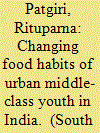

|
|
|
|
|
| Summary/Abstract |
The liberalisation of the Indian economy facilitated significant changes in the eating habits of urban middle-class Indians since the 1990s. While there have been studies on food and Indian society before liberalisation, on ‘street food’ and the impact of restaurants and practices of eating out after liberalisation in India, the rising phenomenon of ‘ordering in’ has remained relatively under-researched. This article examines the impact of online food delivery service providers on the food habits of urban middle-class youth in India. It finds that the combined effects of demonetisation and the related push towards digitalisation strengthened online food delivery services in the market. Subsequently, ordering in has become a regular part of the eating culture of urban middle-class youth, particularly during the COVID-19 pandemic. The study offers new insights into remarkable recent changes in the psycho-social and socio-economic structures of Indian society, affecting both consumers and service providers.
|
|
|
|
|
|
|
|
|
|
|
|
|
|
|
|
| 4 |
ID:
104360
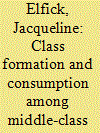

|
|
|
|
|
| Publication |
2011.
|
| Summary/Abstract |
This paper explores the role of consumption in defining Chinese middle-class identity by examining the consumption practices of urban professionals. It is widely agreed that China has a thriving middle class. The exact definition of this middle class, however, is disputed by scholars and the Chinese popular press. Debates about class are also manifest in the daily lives of urban professionals. One of the most interesting areas in which identity is contested is that of consumption. The research is based on 60 in-depth interviews among professionals conducted in Shenzhen in the period 2004-2010. New wealth means that the myriad of goods on offer is accessible to large sections of the urban population. Professionals have become keen and selective shoppers. Many describe their consumption practices as informed by their own highly individualistic taste. This paper argues that professional consumption practices sometimes express individual taste but, more importantly, serve to articulate a collective social identity.
|
|
|
|
|
|
|
|
|
|
|
|
|
|
|
|
| 5 |
ID:
181680


|
|
|
|
|
| Summary/Abstract |
This article traces the evolution of branded commodity advertising and consumption from corporeal health concerns to the racialisation of beauty through skin-lightening cosmetics in late colonial India. It centres two empirical foci: the marketing of personal hygiene products to Indian markets, and their racialised and gendered consumption. This article argues that the imperial economy tapped into and commodified ideals of cleanliness, beauty and fairness through marketing—ideals that continue to pervade contemporary South Asian communities. Contrary to claims that multinational corporations permeated Indian markets after the economic liberalisation of the late 1980s, there is a much deeper genealogy to the racialised imperial economy operating in European colonies. This article also examines the phenomenological underpinnings of imperial whiteness in colonial encounters to demonstrate how certain commodities appealed to Indians as ‘modern’ consumers, as well as how middle-class Indians and local entrepreneurs became active participants in the demand for, consumption and production of personal hygiene commodities.
|
|
|
|
|
|
|
|
|
|
|
|
|
|
|
|
| 6 |
ID:
191309
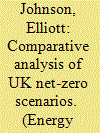

|
|
|
|
|
| Summary/Abstract |
Final energy demand in the UK has remained relatively constant since the 1970s. However, most of the scenarios that model pathways to achieve the UK's net-zero greenhouse gas emissions by 2050 indicate that energy demand reduction (EDR) will be an important pillar of climate change mitigation. Despite this, the UK Government has no clearly defined strategy to reduce demand. This comparative analysis explores the role of EDR across twelve UK-based climate scenarios from four organisations that estimate changes in carbon emission and energy consumption from 2020 to 2050. We focus on changes in final demand across the economy, assessing the scale of ambition and the implications for the rest of the energy system in the context of net-zero. All the pathways explored achieve reductions of at least 32.8% in total final energy demand from 2020 to 2050, suggesting that this is the minimum level of demand reduction required to achieve the development and rollout of the supply side technologies necessary to decarbonise the energy system. Reductions in total final demand of up to 52% are demonstrated. We find that pathways with higher levels of EDR mitigate against technological challenges, such as scaling up renewable energy capacities, are less reliant on carbon-dioxide removal technologies and require less investment – but are characterised by higher levels of social change.
|
|
|
|
|
|
|
|
|
|
|
|
|
|
|
|
| 7 |
ID:
133192
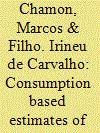

|
|
|
|
|
| Publication |
2014.
|
| Summary/Abstract |
This paper estimates the household income growth rates implied by food demand in a sample of urban Chinese households in 1993-2005. Our estimates, based on Engel curves for food consumption, indicate an average per capita income growth of 6.8% per year in 1993-2005. This figure is slightly larger than the 5.9% per year obtained by deflating nominal incomes by the CPI. We attribute this discrepancy to a small bias in the CPI, which is of a similar magnitude to the one often associated with the CPI in the United States. This result supports the view that Chinese price statistics are reliable. Our estimates indicate stronger gains among poorer households, suggesting that urban inflation up to 2005 in China was "pro-poor," in the sense that the increase in the cost of living for poorer households was smaller than for the average one.
|
|
|
|
|
|
|
|
|
|
|
|
|
|
|
|
| 8 |
ID:
146224


|
|
|
|
|
| Publication |
Cambridge, Polity Press, 2014.
|
| Description |
xi, 207p.: mappbk
|
| Series |
China Today Series
|
| Standard Number |
9780745669717
|
|
|
|
|
|
|
|
|
|
|
|
Copies: C:1/I:0,R:0,Q:0
Circulation
| Accession# | Call# | Current Location | Status | Policy | Location |
| 058744 | 339.470951/LIA 058744 | Main | On Shelf | General | |
|
|
|
|
| 9 |
ID:
113968
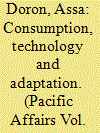

|
|
|
|
|
| Publication |
2012.
|
| Summary/Abstract |
On the edges of the digital world in India, there are millions of mobile phone users. To cater for these consumers, an economy of mobile phone care and repair has emerged in almost every town. Through the experiences of consumers and repairers, this article explores technology distribution, service practices and economic opportunity. How do they learn their trade? How do they make a living? And how do they position themselves in relation to the official branded manufacturers and licensed agents? Conceptually, the article is concerned with the nexus between consumer culture, the Indian middle class and the poor and how they engage global capitalism. It argues that middle-class ideologies and practices of consumption are both exclusive and expansive. At the same time, the poor seek to engage this economy by tapping into the unauthorized sector that responds to their demands for local participation in the global economy, while keeping them also at a certain distance from the forms and symbolic capital of the new economy.
|
|
|
|
|
|
|
|
|
|
|
|
|
|
|
|
| 10 |
ID:
185086
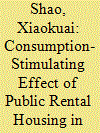

|
|
|
|
|
| Summary/Abstract |
China's public rental policy creates opportunities for poor households to rent apartments at low rental prices. In addition to such an impact, we argue that public rental housing increases the purchasing power of the poor and therefore enhances the income elasticity of consumption, i.e., the percentage of consumption increment due to a 1 percent increase in income. Based on a nationwide dataset from China, the Chinese Household Income Project 2018, we find that public rental housing significantly increases the marginal impact of household disposable income on consumption. Specifically, our analysis suggests that public rental apartments could increase the income elasticity of consumption demand by 18 percent among all rental households and by 24 percent among rental households with below-average income. We also find that the effect of public rental housing on income elasticity of consumption is stronger for service consumption than for nonservice consumption. These results suggest that a well designed public rental policy could not only promote consumption in favor of the service industry but also alleviate the undesirable consequences of the unbalanced consumption structure caused by income inequality.
|
|
|
|
|
|
|
|
|
|
|
|
|
|
|
|
| 11 |
ID:
179681


|
|
|
|
|
| Summary/Abstract |
I investigate how the Covid-19 epidemic affected consumption and prices in a part of the Nordic electricity market that has a high penetration of intermittent renewable energy: Denmark and the southernmost part of Sweden. In sharp contrast to studies of other regions, I find no overall drop in consumption in this region. However, the distribution of consumption shifted away from peak hours. Nonetheless, prices dropped significantly, with a decline that started well before the imposition of societal restrictions in Denmark. Periods where wind power covered all of local load saw prices collapse towards zero with little variance under the Covid-19 epidemic. The results have important policy implications. Energy-only markets may fail to provide sufficient investment incentives for renewable energy when penetrations of such generation are already high. Policies and technologies that shift load from peak to non-peak times may further erode market incentives.
|
|
|
|
|
|
|
|
|
|
|
|
|
|
|
|
| 12 |
ID:
140445
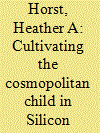

|
|
|
|
|
| Summary/Abstract |
How does cosmopolitanism emerge in regions characterised by diversity and difference? This article examines the ways parents living in Silicon Valley, California seek to realise, maintain and manage ‘cultural and political multiplicities’ in their efforts to create cosmopolitan environments and sociality for their children and families. Grappling with the tension between cultivating academic achievement and cosmopolitan sociability, I explore how parents create opportunities for cosmopolitanism experiences and spaces, moving away from schooling towards education through international travel and philanthropy. The article reflects upon the challenges parents face as they attempt to realise their good intentions, ideas and attitudes to facilitate cosmopolitan sociability in a region where diversity is located in everyday interactions and encounters. I conclude by drawing connections between changing practices and how structural constraints influence parents’ approaches to cultivating cosmopolitanism over time.
|
|
|
|
|
|
|
|
|
|
|
|
|
|
|
|
| 13 |
ID:
169263
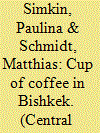

|
|
|
|
|
| Summary/Abstract |
This study deals with the contemporary dynamics of urban life in Bishkek. Since the dissolution of the Soviet Union, Central Asian societies have experienced widespread political, economic and socio-cultural transformations. In this context, Western or globalized cultural modes and trends influence Kyrgyzstan's social and cultural life. One of these trends is the increasingly popular coffee culture, with its attendant high-grade coffee brands and fancy cafés changing established consumption patterns. This article focuses primarily on cafés as new places of consumption and communication, but it also examines the intentions and strategies of the café pioneers. We reflect on the emergence of coffee and cafés in Bishkek and show how they have integrated in urban life as ‘third places’. Coffee is breaking away from its commonly soluble form and moving toward an expensive lifestyle product, while the new cafés offer a place for communication that has not existed before.
|
|
|
|
|
|
|
|
|
|
|
|
|
|
|
|
| 14 |
ID:
146878
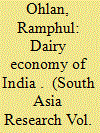

|
|
|
|
|
| Summary/Abstract |
India remains the world’s largest producer and consumer of milk. The present study empirically evaluates the transformations in demand and supply of dairy products in India, identifying that the share of dairy products in the food basket has significantly increased among both rural and urban consumers. While demand for dairy products is highly elastic and related to income, the analysis also shows large regional disparities in production and per capita availability of milk in India. After examining various aspects of dairy consumption and production patterns in India, the article also includes policy considerations to improve dairy production. It suggests that to stimulate dairy sector development and reduce inequality in dairy products consumption in India, milk and milk products should be included in the diet provided through the Midday Meal Schemes for primary education children. Overall, to meet the growing demand for dairy products, given their role in food security, the Government of India should continue to aim for sustained growth.
|
|
|
|
|
|
|
|
|
|
|
|
|
|
|
|
| 15 |
ID:
157719
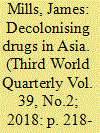

|
|
|
|
|
| Summary/Abstract |
This article examines a drugs trade in Asia that has been largely forgotten by historians and policy-makers, that in cocaine. It will briefly trace some of the contours of this commerce and the efforts to control it. It will also assess how successful these efforts were. The article is designed to contribute fresh perspectives on recent controversies in the historiography of drugs in Asia to argue that the agendas and agency of consumers are central to understanding why markets have formed there for psychoactive substances in the modern period.
|
|
|
|
|
|
|
|
|
|
|
|
|
|
|
|
| 16 |
ID:
144172
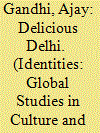

|
|
|
|
|
| Summary/Abstract |
This article examines how Old Delhi is represented and recreated in contemporary India. Delhi’s old city was once the locus of pre-colonial Mughal sovereignty. It is now often encountered via nationalist spectacles, mass-media images and consumption practices. Paralleling neo-liberalism’s onset in the 1990s, its street food, bazaar spaces and historical monuments have been avidly appropriated by reigning institutions and classes. Old Delhi suggests that which the new India has left behind; yet this displacement also elicits longing for what has been lost.
This medieval remnant can therefore be considered the site of nostalgia consumed by a globalised middle class. This article presents an ethnography of Old Delhi’s invocation in New Delhi’s cultural landscape, including malls, newspapers, heritage sites, hotels, and food courts. In triangulating among the realms of nationalist nostalgia, middle-class identity and mediated consumption, it emphasises how India’s neoliberal emergence is bound up with the co-opting of the past.
|
|
|
|
|
|
|
|
|
|
|
|
|
|
|
|
| 17 |
ID:
163507


|
|
|
|
|
| Summary/Abstract |
In order to change the situation that reimbursement rate of the new rural cooperative medical care system (NCMS) was too low to alleviate farmers medical burden, in August 2012, China began to expand the coverage of the NCMS to include the treatment of critical illnesses. Could more effective health insurance promote the consumption of rural residents? We studied the impact of the critical illness insurance (CII) on rural household consumption, and find that the CII increases per capita household daily consumption by >15%. But healthcare and medical expenditures have not been affected. Our comparison of outcomes for households with different levels of consumption and income shows the CII mainly promote the consumption of rural affluent family, but no incentive for poor family, resulting in deterioration of consumption inequality of rural households. The finding is robust to various alternative hypotheses and specifications.
|
|
|
|
|
|
|
|
|
|
|
|
|
|
|
|
| 18 |
ID:
105795


|
|
|
|
|
| Publication |
2011.
|
| Summary/Abstract |
An explorative survey was carried out on rural and semi-urban households to find out the energy consumption pattern with respect to socio-demographic and geographic factors in Bangladesh by using stratified random sampling technique. The study revealed that 100% of the households used biomass, 98% kerosene, 61% electricity, 23% LPG and 5% candle in the rural areas. In the semi-urban areas, 100% of the households used electricity, candle and natural gas, 60% kerosene and 13% petrol. Households' mean expenditure for total energy was US$ 5.34 (SE, 0.43) with total income US$ 209.84 (SE, 6.69) month-1 in the rural areas, while it was US$ 6.20 (SE, 1.35) in the semi-urban areas with the total income US$ 427.76 (SE, 24.19) month-1. This study may be a useful baseline information to energy policy makers in Bangladesh.
|
|
|
|
|
|
|
|
|
|
|
|
|
|
|
|
| 19 |
ID:
119159
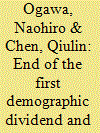

|
|
|
|
|
| Publication |
2013.
|
| Summary/Abstract |
This paper sheds light on the nexus of age compositional shifts and the generation of the first demographic dividend over the past several decades in China, and also discusses how this dividend could be extended We first estimate how long China's first demographic dividend will last and then compare the computed results for China with those for other selected Asian countries in order to place the Chinese case in a wider perspective. Furthermore, in view of the possibility that China's first demographic dividend will turn negative in 2014, we offer insight into how and to what extent China's labor market needs to adjust and how much labor income must increase for the first demographic dividend to remain positive up to year 2050. For this goal to be achieved, the labor income age profile needs to be shifted to a considerable extent. We conduct an exercise in which the 2007 peak labor income age of 32 years is shifted to 40 years. In the case of the elderly, this implies an annual labor income growth of 3.1 percent over the period of 39 years. Throughout this paper, we draw on a variety of computed results derived from the Chinese component of the global "National Transfer Accounts" project.
|
|
|
|
|
|
|
|
|
|
|
|
|
|
|
|
| 20 |
ID:
093542
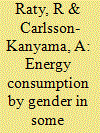

|
|
|
|
|
| Publication |
2010.
|
| Summary/Abstract |
Household total energy use has been estimated in numerous studies in recent decades and differences have mainly been explained by levels of income/expenditure. Studies of gender consumption patterns show that men eat more meat than women and drive longer distances, potentially leading to higher total energy use by men. In this study we calculated the total energy use for male and female consumption patterns in four European countries (Germany, Norway, Greece and Sweden) by studying single households. Significant differences in total energy use were found in two countries, Greece and Sweden. The largest differences found between men and women were for travel and eating out, alcohol and tobacco, where men used much more energy than women. We suggest that these findings are policy relevant for the EU, which aims to mainstream gender issues into all activities and to lower its total energy use.
|
|
|
|
|
|
|
|
|
|
|
|
|
|
|
|
|
|
|
|
|